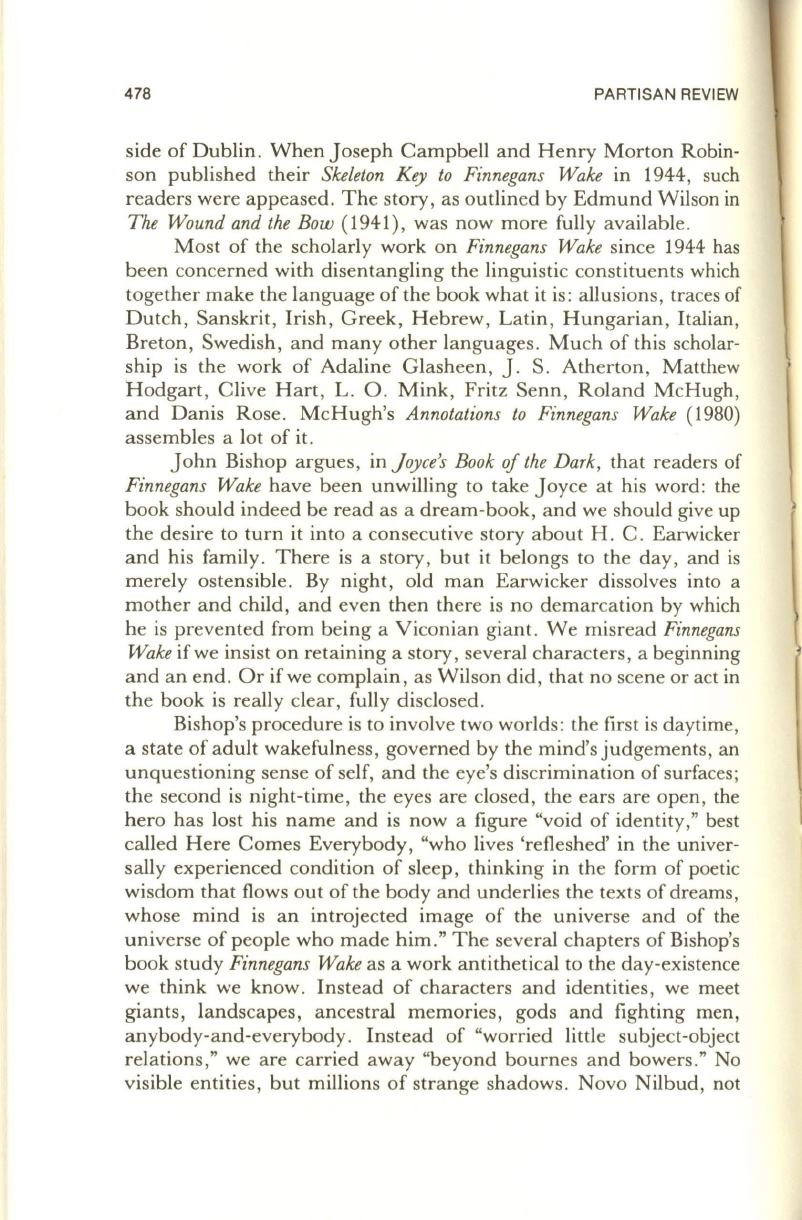
478
PARTISAN REVIEW
side of Dublin. When Joseph Campbell and Henry Morton Robin–
son published their
Skeleton
Key
to Finnegans Wake
in 1944, such
readers were appeased. The story, as outlined by Edmund Wilson in
The Wound and the Bow
(1941), was now more fully available.
Most of the scholarly work on
Finnegans Wake
since 1944 has
been concerned with disentangling the linguistic constituents which
together make the language of the book what it is : allusions, traces of
Dutch, Sanskrit, Irish, Greek, Hebrew, Latin, Hungarian , Italian,
Breton, Swedish, and many other languages. Much of this scholar–
ship is the work of Adaline Glasheen, J . S. Atherton, Matthew
Hodgart , Clive Hart , L . O . Mink, Fritz Senn, Roland McHugh,
and Danis Rose. McHugh's
Annotations to Finnegans Wake (1980)
assembles a lot of it.
John Bishop argues , in
Joyce's Book
of
the Dark,
that readers of
Finnegans Wake
have been unwilling to take Joyce at his word : the
book should indeed be read as a dream-book, and we should give up
\
the desire to turn it into a consecutive story about H . C . Earwicker
and his family . There is a story, but it belongs to the day, and is
merely ostensible . By night, old man Earwicker dissolves into a
mother and child, and even then there is no demarcation by which
he is prevented from being a Viconian giant. We misread
Finnegans
Wake
if we insist on retaining a story, several characters, a beginning
and an end. Or if we complain, as Wilson did, that no scene or act in
the book is really clear, fully disclosed .
Bishop's procedure is to involve two worlds: the first is daytime,
a state of adult wakefulness, governed by the mind's judgements, an
unquestioning sense of self, and the eye's discrimination of surfaces ;
the second is night-time, the eyes are closed , the ears are open, the
hero has lost his name and is now a figure "void of identity," best
called Here Comes Everybody, "who lives 'refleshed' in the univer–
sally experienced condition of sleep, thinking in the form of poetic
wisdom that flows out of the body and underlies the texts of dreams,
whose mind is an introjected image of the universe and of the
universe of people who made him." The several chapters of Bishop's
book study
Finnegans Wake
as a work antithetical to the day-existence
we think we know. Instead of characters and identities, we meet
giants, landscapes, ancestral memories, gods and fighting men,
anybody-and-everybody . Instead of "worried little subject-object
relations," we are carried away "beyond bournes and bowers ." No
visible entities, but millions of strange shadows. Novo Nilbud, not


